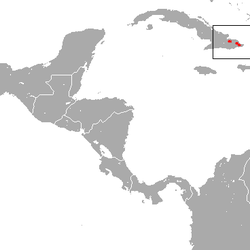Cuban weevil
| Cuban weevil | ||||||||||||
|---|---|---|---|---|---|---|---|---|---|---|---|---|

Cuban sand weevil ( Solenodon cubanus ) |
||||||||||||
| Systematics | ||||||||||||
|
||||||||||||
| Scientific name | ||||||||||||
| Solenodon cubanus | ||||||||||||
| Peters , 1861 |
The Cuban slot weevil or Almiquí ( Solenodon cubanus , syn .: Atopolage cubana ) is a species of mammal belonging to the order of the insectivore (Eulipotyphla). Together with the Dominican or Haiti sand weevil , it forms the family of sand weevils (Solenodontidae). It is endemic and endangered on the island of Cuba .
features
Like all slot weevils, the Cuban slot weevil resembles a large, stocky shrew . It is characterized by the long, trunk-like nose, the legs and tail are almost hairless. It differs from the second species of slot weevil, the Dominican slot weevil, in its longer, softer fur, which is also darker - mostly black-brown - in color. The head body length is around 28 to 39 centimeters and the weight is 0.8 to 1 kilogram.
Like all Schlitzrüssler produced the Cuban Schlitzrüssler in the mandibular salivary gland , a nerve agent , which allows him to overwhelm relatively large prey.
distribution and habitat
Cuban sand weevils are endemic to the island of Cuba . Today its range is limited to small regions in the southeast of the island. Their habitat is forests, sometimes they also inhabit grasslands.
Way of life
The way of life of the Cuban weevil is less explored than that of its Dominican relative. He is mainly nocturnal and spends the day hidden in rock crevices, holes in the ground or self-dug burrows. When foraging for food, they look for something to eat either on the surface or under the ground with their proboscis-like nose, sometimes they also use the strong claws of their front paws.
Cuban weevils are omnivores, but they mainly eat meat. Their menu includes bipods , insects , earthworms , but also small vertebrates and sometimes fruits and other plant material.
Little is known about reproduction either. Presumably, it should largely correspond to that of the Dominican sand weevil.
threat
The main reasons for the threat to the Cuban sand weevil are, on the one hand, the stalking of animals such as domestic dogs , house cats and mongooses . On the other hand, the destruction of their habitat continues to restrict their areas of distribution.
After it was first described in 1861, only a few specimens of this species were found, and in the mid-20th century it was feared that it might already be extinct. Since the 1970s, specimens have been found in the eastern regions of Cuba, most recently in 1999, 2003 and 2012. The last time they were found in 2012, Cuchillas were found in the area of El Toldo, in the Alexander von Humboldt National Park and Biosphere Reserve del Toa found seven healthy specimens. The biologist Dr. Rafael Borroto Páez from the Cuban Environment Ministry interpreted this as a sign of a slow recovery of the population. The species is considered rare, the IUCN lists it as endangered .
literature
- Ronald M. Nowak: Walker's Mammals of the World. 2 volumes. 6th edition. Johns Hopkins University Press, Baltimore MD et al. 1999, ISBN 0-8018-5789-9 .
Individual evidence
- ^ Samuel Turvey: Solenodontidae . In: Handbook of the Mammals of the World: Insectivores, Sloths, Colugos . tape 8 . Lynx Edicitions, Barcelona 2018, ISBN 978-84-16728-08-4 , pp. 620-627 .
- ↑ Seven rare almiquíes sughted in Cuba's Alejandro de Humboldt National Park ( Memento of the original from May 16, 2012 in the Internet Archive ) Info: The archive link was inserted automatically and has not yet been checked. Please check the original and archive link according to the instructions and then remove this notice. , Granma, April 11, 2012
Web links
- Information on Animal Diversity Web
- Atopogale cubana in the endangered Red List species the IUCN 2018 Posted by: Kennerley, R. Turvey, ST & Young, R., 2015. Accessed August 24, 2018th
- Spiegel Online The comeback of the weevil

